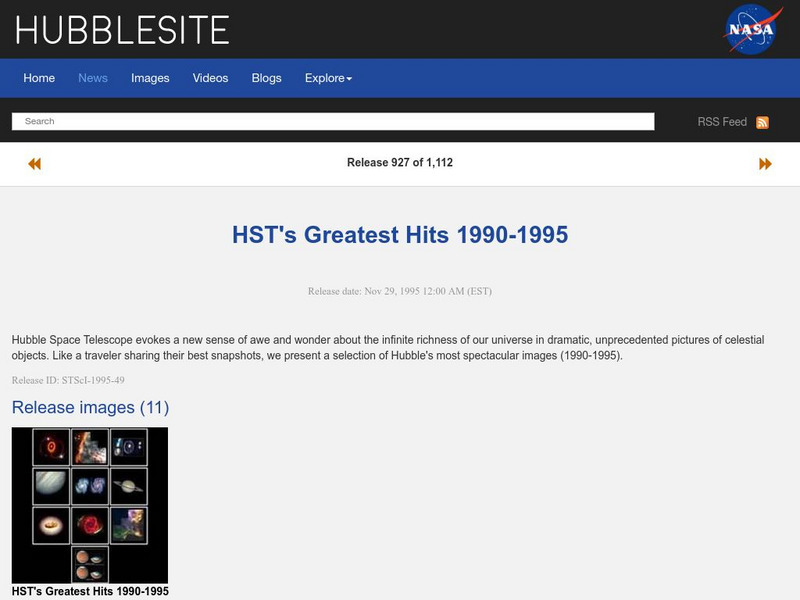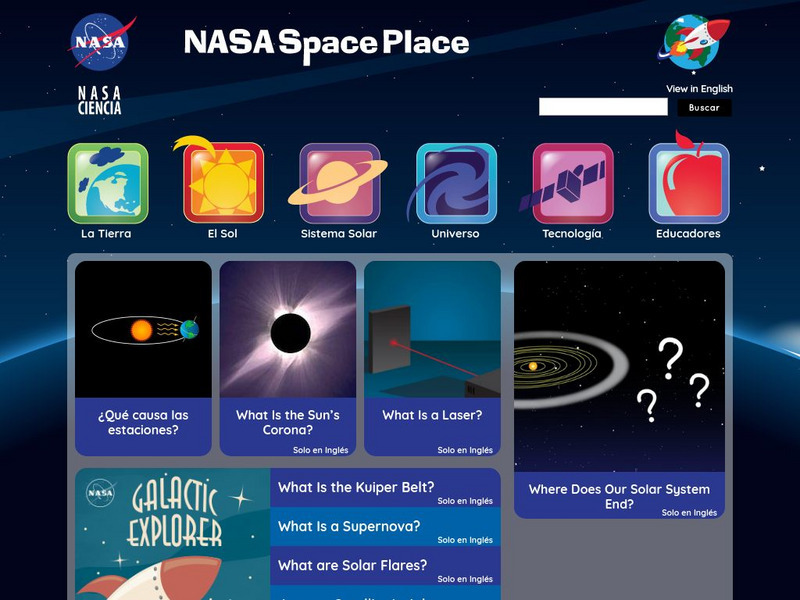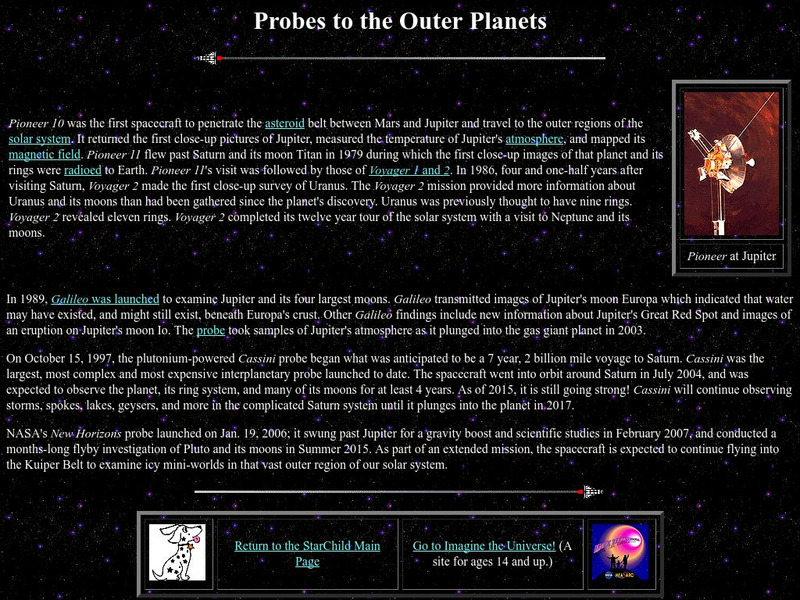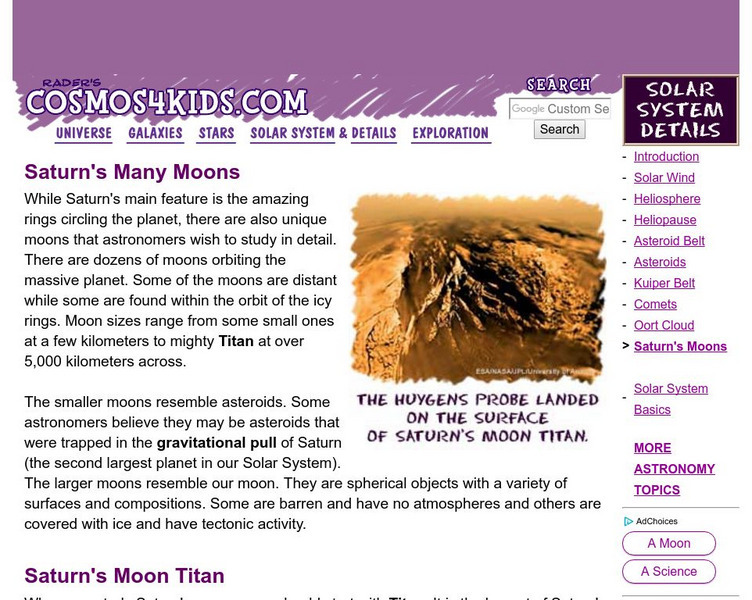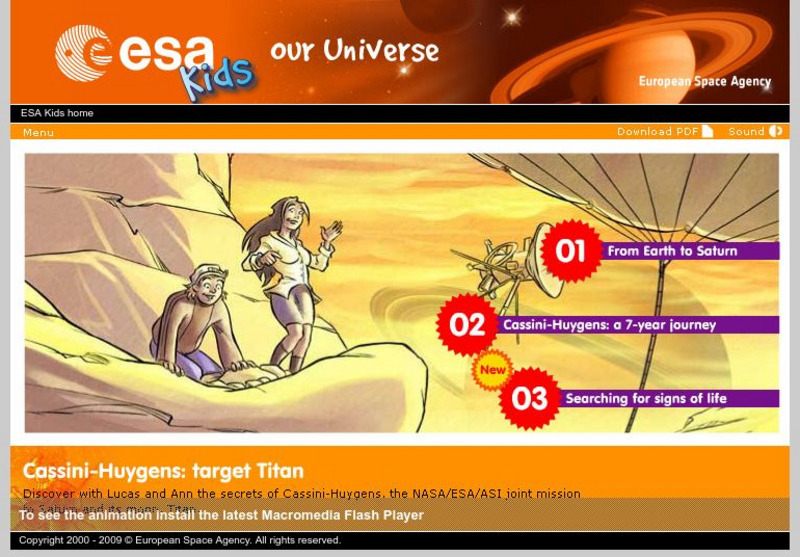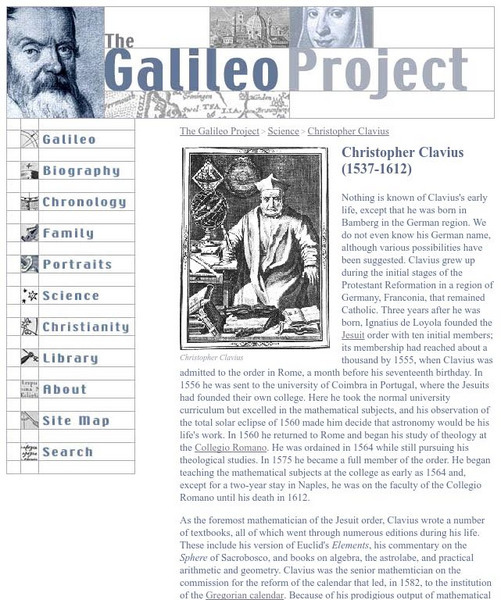NASA
Nasa: Image Science Center: Ask the Space Scientist
A NASA scientist, Dr. Sten Odenwald, answers many students' questions. Topics include planets, galaxies, black holes, the origin of the universe, and common misconceptions about space.
Space Telescope Science Institute
Hubble Space Photographs: Hst's Greatest Hits 1990 1995
Breathtaking images from the Hubble Space Telescope give a new perspective to our world.
DOGO Media
Dogo News: Week of 10 21 13: Does It Rain Diamonds on Saturn and Jupiter?
Article reports on research that suggests that rain on Saturn and Jupiter may be made of diamonds. Includes a brief video.
PBS
Nova: Anatomy of the Rings
Thanks to the Cassini spacecraft, you can view numerous pictures of Saturn's rings. There are also answers to eleven different questions about the rings.
NASA
Nasa Space Place: El Space Place
NASA's space science site for kids - en Espanol. Features a wide range of activities, including games, projects, animations, and more. Also contains useful information on basic physics, chemistry, and other natural sciences, offering...
NASA
Nasa Star Child: Saturn, the Ringed Planet (Level 1)
A good simple introduction to planet Saturn for young students. Audio content available. Vocabulary words linked to glossary of terms. Printable version available.
NASA
Nasa Star Child: Probes to the Outer Planets (Level 2)
This site has a description of the many probes sent to the outer planets, including pictures and vocabulary words linked to a glossary of terms. Other links on interesting facts and more detailed information are also included.
Other
University of Leicester: The Solar System
Resource explores the solar system, with an in depth discussion of each of the planets and their properties.
NASA
Nasa: Voyager Missions
This NASA site takes a look at the Voyager mission, now in its 25th year. Content includes a look at Voyager's mission, an overview of the spacecraft, the latest news, and much more.
NASA
Jpl: Voyager: The Interstellar Mission
The Jet Propulsion Laboratory (JPL) at NASA provides a detailed history of the Voyager Project, including a description of the spacecraft and Voyager's planetary tour.
Enchanted Learning
Enchanted Learning: The Planets
This survey of the planets includes all the basics, size, mass, atmosphere, length of day, and the like. It features interactive activities and learning exercises and compares all of the planets in colorful tables.
NASA
Nasa: Solar System
This resource provides a general overview of all the planets in the solar system, as well as the sun, various comets and asteroids, the deep space network, and the latest solar system news.
NASA
Nasa: Solar System Exploration
Enter our solar system to interact with the planets, moons, asteroids, meteors, and more. Investigate with NASA scientists and explore missions related to space exploration. Read facts, compare statistics, look through resources, and...
BBC
Bb Ci Space: Solar System
Take a journey through the solar system with this interactive guide. Includes planetary history, "travel information," "tourist highlights," and video clips. Games and quizzes include a Solar System jigsaw that prompts the student to...
NASA
Nasa: Cassini Solstice Mission Timeline
Interactive timeline allows user to view the entire history of the Cassini Solstice Mission to Saturn due to be completed in 2017.
NASA
Nasa: Solar System Exploration
This stunning site on the solar system gives a great overview of the planets and our sun. Learn about each object's size, vital statistics, and moons. Then go on for a more in depth look at these objects in the column on the left.
European Space Agency
European Space Agency: Cassini Huygens
This is the home page of the Huygens probe, which will be launched into Saturn's moon Titan's atmosphere.
Cosmos 4 kids
Cosmos4 Kids: Solar System: Saturn
Learn the basic facts about the planet Saturn. The brief, to the point text makes this site most suitable for younger researchers.
Cosmos 4 kids
Cosmos4 Kids: Solar System Details: Moons of Saturn
Explore the dozens of Saturn's moons orbiting the second largest planet of our solar system. Find out about the Cassini space mission which explored Saturn's largest moon, Titan.
European Space Agency
European Space Agency: Esa Kids: Our Universe: Cassini Huygens
An introduction to Cassini-Huygen, a joint mission to investigate Saturn and its moon, Titan. Told in an animated comic format.
NASA
Nasa: Jupiter Voyager 1
This site from NASA provides general information about the Voyager 1 spacecraft which visited Jupiter in 1979 and Saturn in 1980. Voyager is now the most distant man made object in the universe.
NASA
Nasa: Missions: Jupiter: Pioneer 11
Following closely after Pioneer 10, this was the second mission to visit Jupiter. This website provides background information about the mission and links to more detailed data.
Rice University
Galileo Project: Christopher Clavius
This site from The Galileo Project of the Rice University provides a biography of Clavius including an excerpt from his writings. A picture is provided in this article along with links to additional information.
University of Colorado
University of Colorado: Cassini Uvis Ultraviolet Imaging Spectrograph
This is the home page of the team that built the Ultraviolet Imaging Spectrograph carried by the Cassini mission to Saturn.



